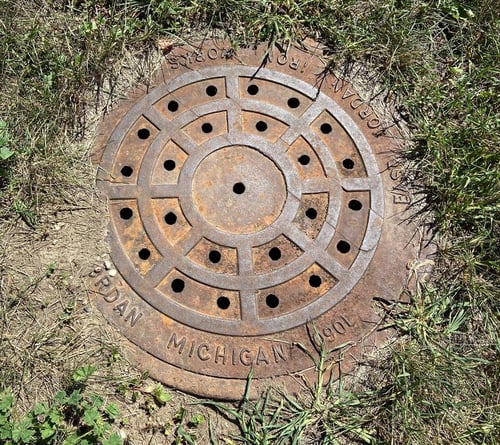From saliva to sewers
MSU researchers use innovative methods to fight COVID-19
Since the identification of the novel coronavirus, researchers from around the world have been looking for ways to predict the next COVID-19 outbreak. At Michigan State University, two successful projects focused on early detection involve collecting saliva and wastewater samples, which are excellent at revealing early COVID-19 outbreaks. Human saliva can hold traces of the virus even before an individual shows symptoms. Jack Lipton, chair of the College of Human Medicine’s Department of Translational Neuroscience, has found a better way to use saliva — instead of the uncomfortable nasal swab — to test large pools of samples for the novel coronavirus.
Human saliva can hold traces of the virus even before an individual shows symptoms. Jack Lipton, chair of the College of Human Medicine’s Department of Translational Neuroscience, has found a better way to use saliva — instead of the uncomfortable nasal swab — to test large pools of samples for the novel coronavirus.
Lipton and his team lead the MSU COVID-19 Early Detection Program, an innovative program to detect asymptomatic people through saliva testing. Lipton’s team developed a low-cost solution for the university that allows users to collect their own samples with the Spartan Spit Kit. Since early detection remains critical to mitigating the spread of the novel coronavirus, MSU is asking all students, faculty and staff who are on campus or in the East Lansing area to enroll in the program.
Once enrolled, people will be contacted at various times throughout the fall semester to pick up a Spartan Spit Kit, provide a saliva sample and return the kit to a walk-up or drive-through location on campus. Once the sample is processed, they are contacted and told whether they need to follow up with a clinical COVID-19 test. Personal information collected through the program is protected and the extent of involvement, like the frequency of provided samples, is entirely up to the individual.
Lipton further speeds the turnaround time and minimizes the use of testing resources through an innovative pooling strategy: Each participant’s saliva is placed into two pools of saliva, each with 10 unique samples from other participants. If someone in the pool has COVID-19, both pools they are in come back positive and they are advised to have further testing to confirm a positive diagnosis. If all samples in both pools are negative for COVID-19, everyone in those pools is cleared.
Lipton and his team have the capacity to test around 2,000 saliva samples per day, or 10,000 per week. This voluntary initiative will monitor asymptomatic spread of COVID-19 among MSU faculty, staff and students throughout the fall semester. Several other universities are testing saliva samples, or using pooling strategies, but none has combined both like MSU.
Lipton developed this capability for MSU after encountering obstacles among academic labs to assist in the fight against COVID-19. This resulted in an op-ed in the Wall Street Journal and several national television appearances in which he proposed the creation of a network of academic labs to serve in emergencies as a biomedical national guard.
“We could utilize university laboratories across the country, coordinated by the federal government, to quickly stand up for pandemics or other outbreaks when sophisticated biomedical testing is needed,” Lipton said. “Academic labs have the experts with the skills and knowledge to help our national response to be proactive when possible, and reactive when needed, for pandemics or other disasters.” Another early clue to a potential COVID-19 outbreak can be found in our wastewater. Joan Rose, a water microbiologist and Homer Nowlin Chair in water research at MSU, was able to detect a spike of the novel coronavirus in wastewater sampled about eight days before the COVID-19 outbreak connected to a local bar officially was announced.
Another early clue to a potential COVID-19 outbreak can be found in our wastewater. Joan Rose, a water microbiologist and Homer Nowlin Chair in water research at MSU, was able to detect a spike of the novel coronavirus in wastewater sampled about eight days before the COVID-19 outbreak connected to a local bar officially was announced.
Once wastewater samples are brought back to the laboratory, Rose’s team replicates the virus RNA until a detectable level is visible as a glowing fluorescent light using a droplet digital Polymerase Chain Reaction for precise detection.
This not only reveals a positive test, but it also indicates concentrations linked to a location where a possible COVID-19 outbreak is imminent. By gathering up to 14 weekly water samples across campus, Rose and her team hope to be able to provide hyperlocal data.
This means that the team can alert health authorities about increasing levels of the virus simultaneously with increasing COVID-19 cases from the people living or working in a specific area, or even a specific building.
“This can help us to identify, contain and prevent the spread of COVID-19,” said Rose, who also is chair of the COVID-19 Task Force for the International Water Association. “Our goal is to support the university’s and the state’s efforts to open back up while enhancing our surveillance and keeping a watchful eye on the health of our students, faculty, staff and communities.”

Kevin Lavery/WKAR/MSU
Top image credit: Stan Sochay/WKAR/MSU